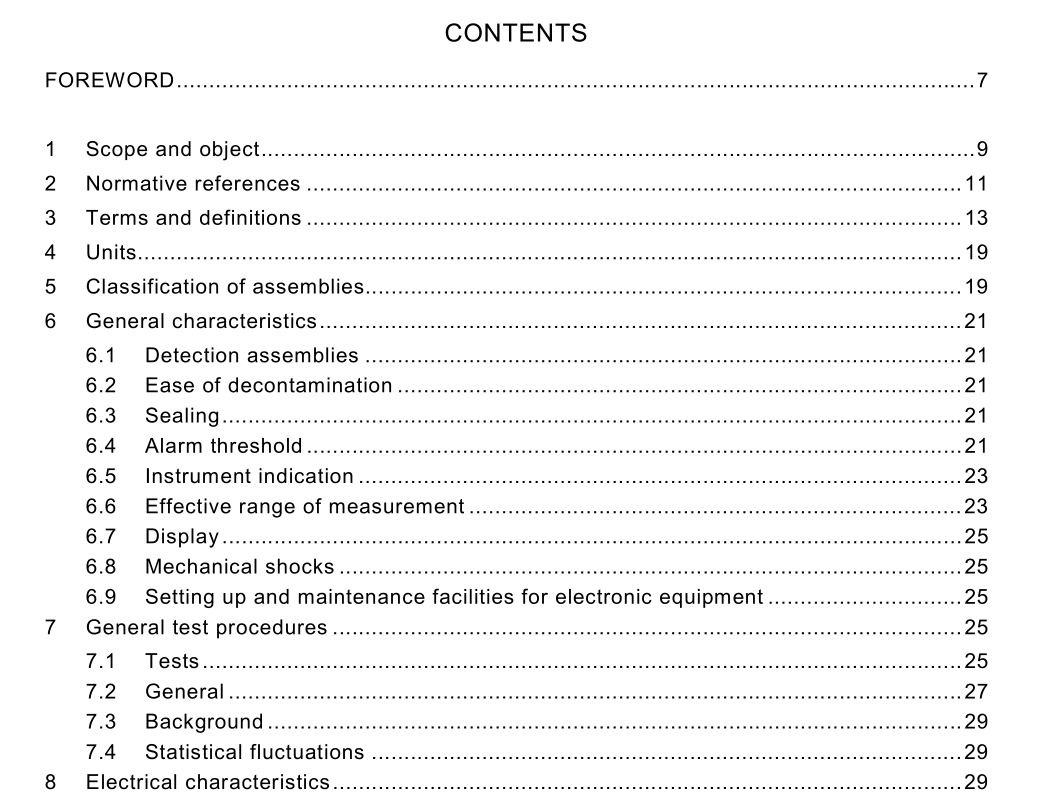IEC 60325 pdf download

IEC 60325 pdf download.Radiation protection instrumentation – Alpha, beta and alpha/beta (beta energy >60 keV) contamination meters and monitors
1 Scope and object
This International Standard is applicable to radiation meters and monitors designed for the direct measurement or the direct detection of surface contamination by alpha and/or beta radiation emitting nuclides and which comprise at least: – a detection assembly (comprising γ counter tube, scintillation detector or semiconductor detector, etc), which may be connected either rigidly or by means of a flexible cable or incorporated into a single assembly. – a measurement assembly. Some meters and monitors consist of detection assemblies and measurement assemblies where it is possible to separate the detector assembly and use alternative detection assemblies. Conformity with the standard can either be achieved by: All combinations of the detection assembly and the measurement assembly conforming to the requirements of this standard. or The detection assembly and the measurement assembly separately conforming to the relevant parts of this standard in isolation. NOTE The use of the latter criteria verifies conformance with this standard but does not infer that calibration of a particular combination of instruments is interchangeable with any other combination. The use of the latter criteria could allow a purchaser to use combinations of assemblies from different manufacturers with confidence.The standard is applicable to: – alpha surface contamination meters; – alpha surface contamination monitors; – beta surface contamination meters; – beta surface contamination monitors; – alpha/beta surface contamination meters; – alpha/beta surface contamination monitors. The latter two are equipment capable of determining alpha and beta contamination simultaneously and displaying the measurement of either: – Alpha (beta, alpha/beta) surface contamination meter An assembly including one or more radiation detectors and associated assemblies or basic function units, designed to measure alpha (beta, alpha/beta) surface emission rate associated with the contamination of the surface under examination. – Alpha (beta, alpha/beta) surface contamination monitor. This standard is also applicable to special purpose assemblies and to assemblies specifically designed for a surface of a particular nature. However, some of the requirements may need to be amended or supplemented according to the particular requirements applicable to such assemblies.If an assembly has been designed to carry out combined functions, it must comply with the requirements pertaining to these different functions. If, on the other hand, it has been designed to perform one function, and, in addition, it is also capable of carrying out other functions, then it must comply with the requirements for the first function, and it would be desirable for it to comply with requirements pertaining to the others. This standard is not applicable to radiation monitors or meters designed to measure or detect beta particles with E max < 60 keV. The object of this standard is to lay down standard requirements and to give examples of acceptable methods, and also to specify general characteristics, general test conditions, radiation characteristics, electrical safety, environmental characteristics, and the requirements of the identification certificate for alpha, beta and alpha-beta contamination meters and monitors.
3 Terms and definitions
The general terminology concerning the detection and measurement of ionizing radiation and nuclear instrumentation is given in IEC 60050(393) and IEC 60050(394). For the purposes of this International Standard, the following definitions apply: 3.1 effective range of measurement range of values of the quantity to be measured over which the performance of a meter or monitor meets the requirements of this standard 3.2 surface emission rate of a source, q/2π π number of particles of a given type above a given energy emerging from the front face of the source per unit time. 3.3 source efficiency, ε ε s ratio between the number of particles of a given type above a given energy emerging from the front face of a source or its window per unit time (surface emission rate) and the number of particles of the same type created or released within the source (for a thin source) or its saturation layer thickness (for a thick source) per unit time 3.4 high efficiency source source in which the efficiency for particles with an energy greater than 5,9 keV is greater than 0,25, including backscattered particles. (This definition applies to beta emitters with a maximum energy >150 keV). 3.5 small area source source whose active surface area has a maximum linear dimension not exceeding 1 cm









